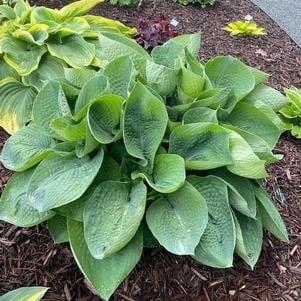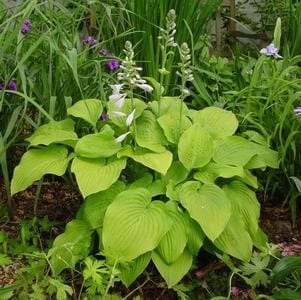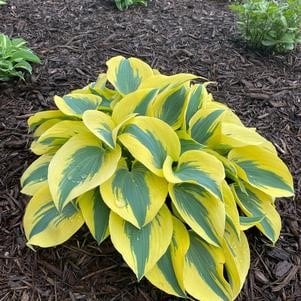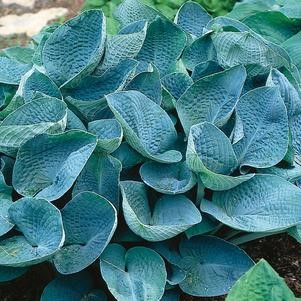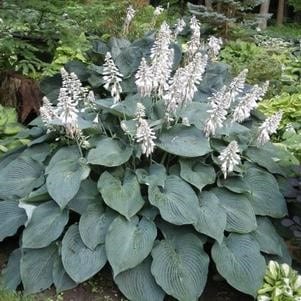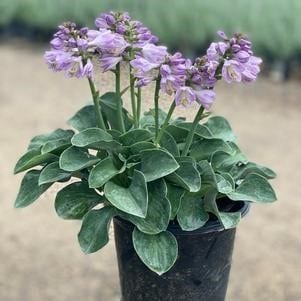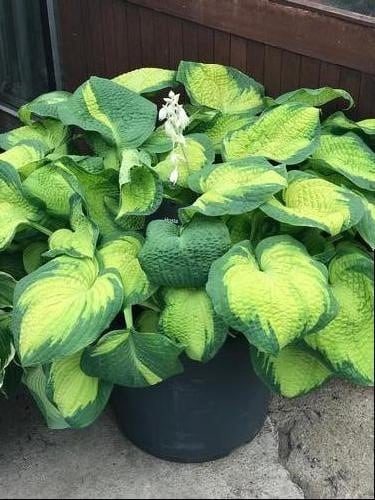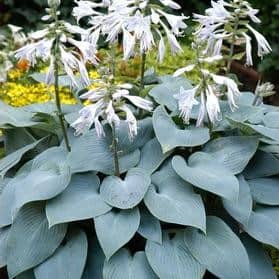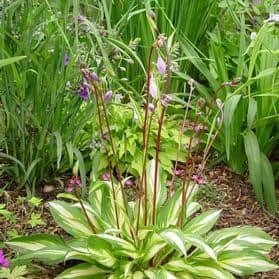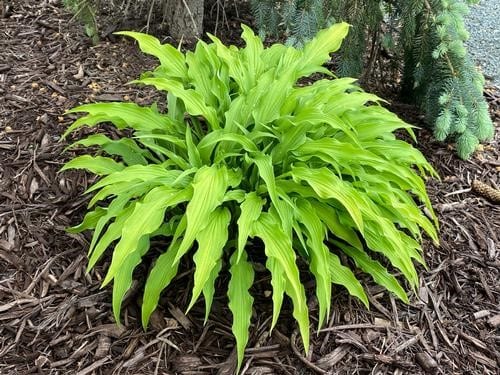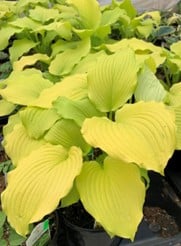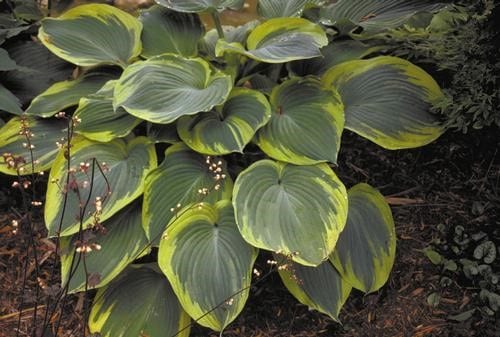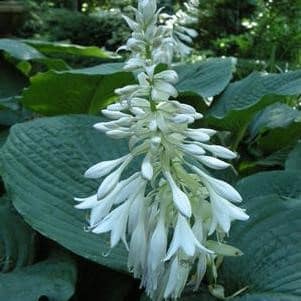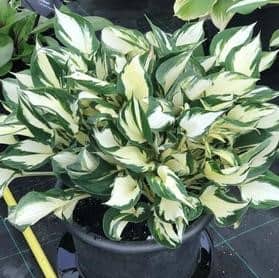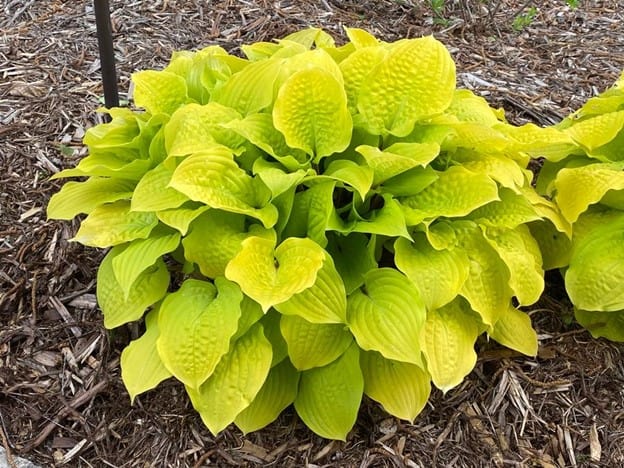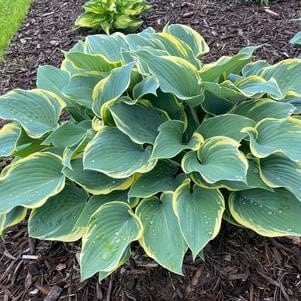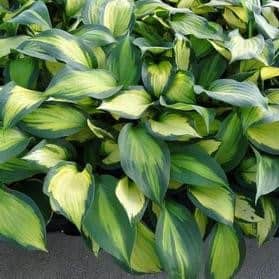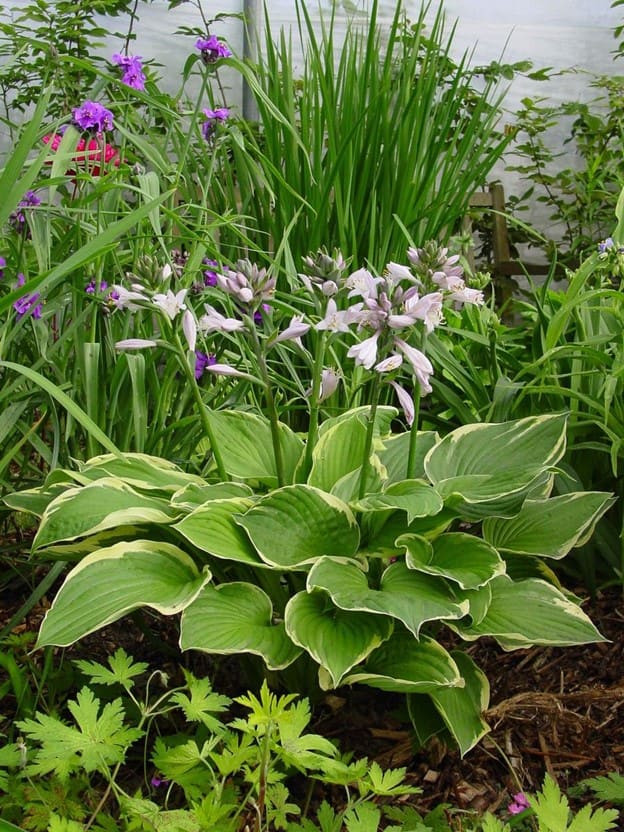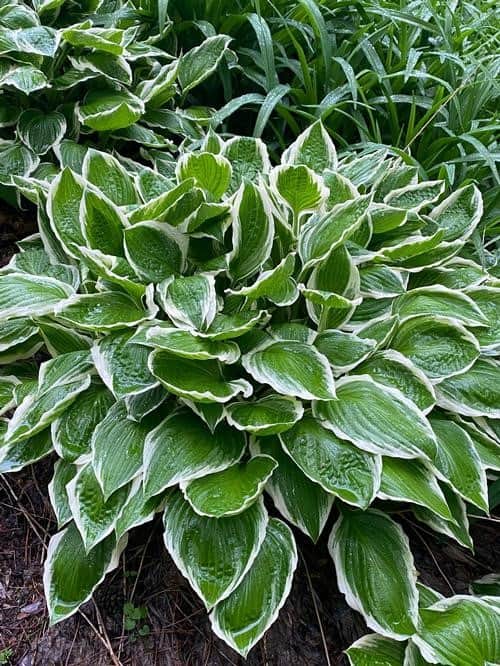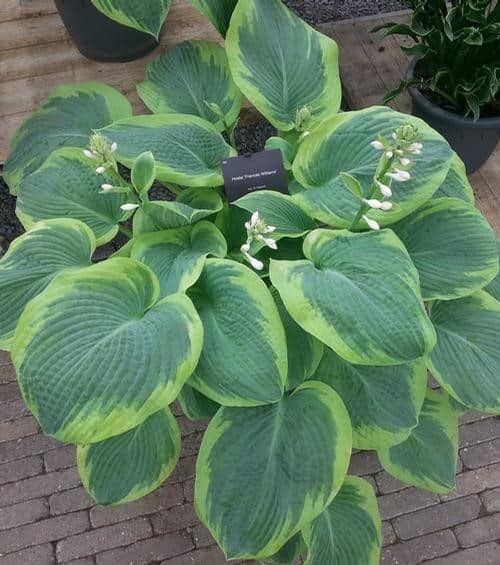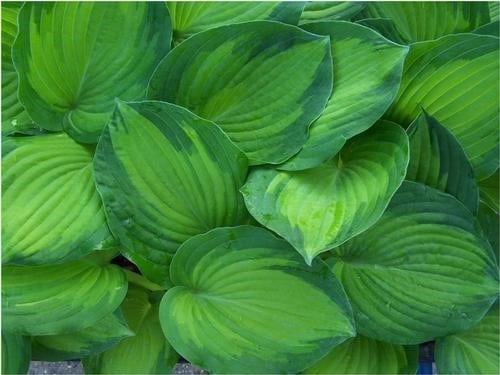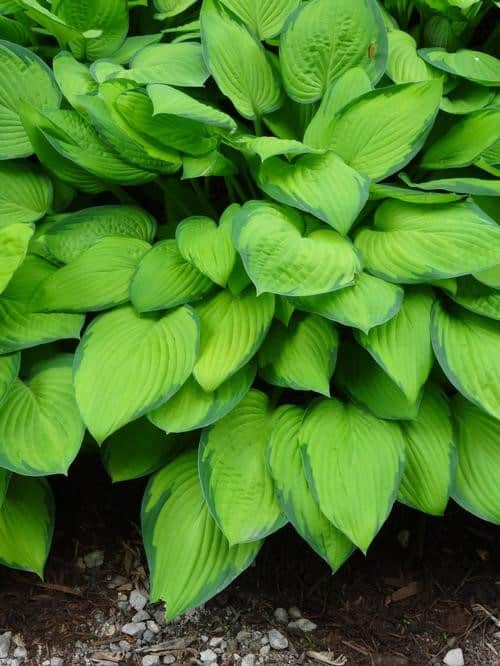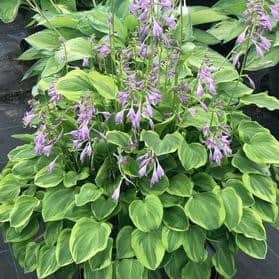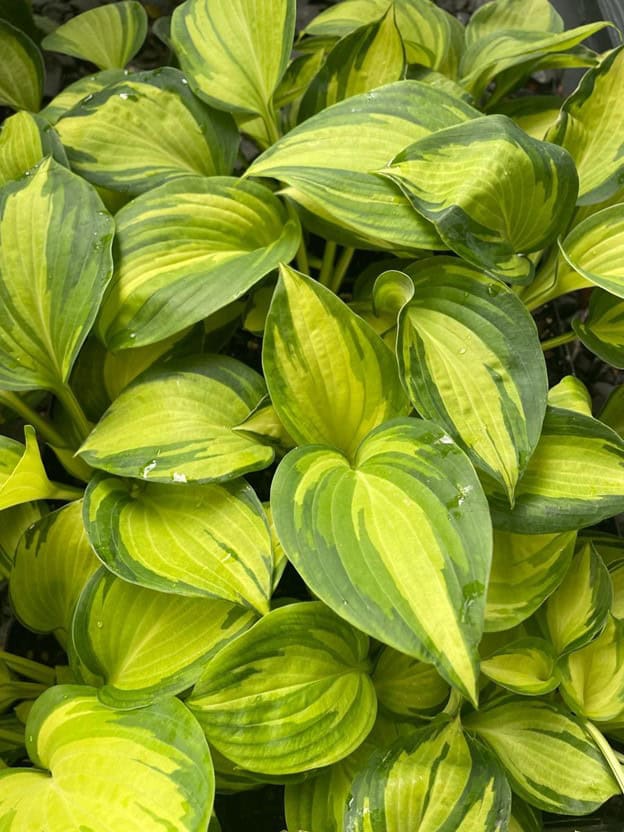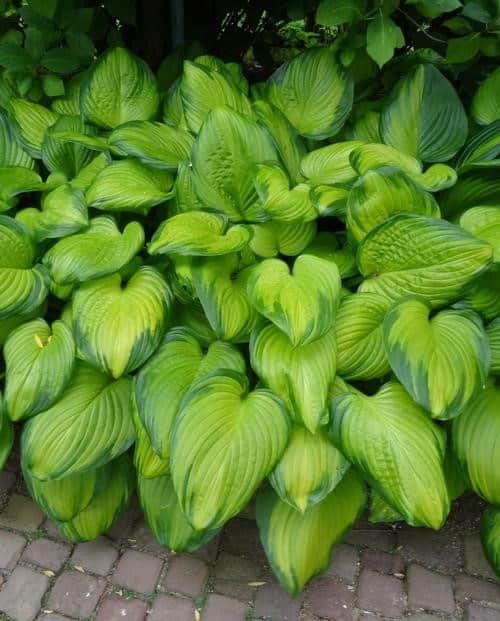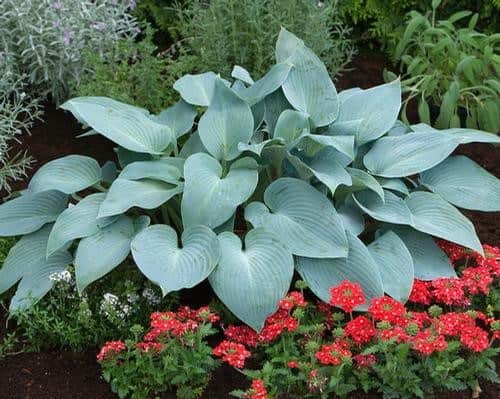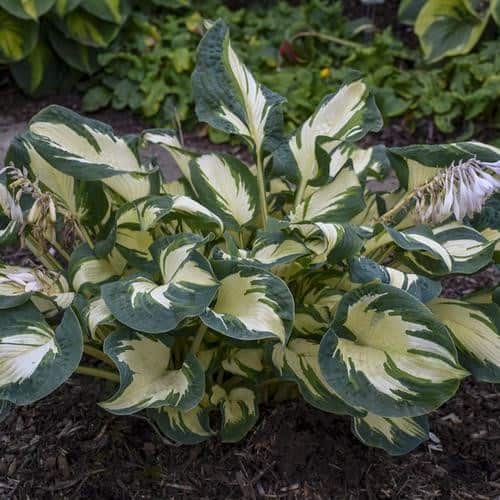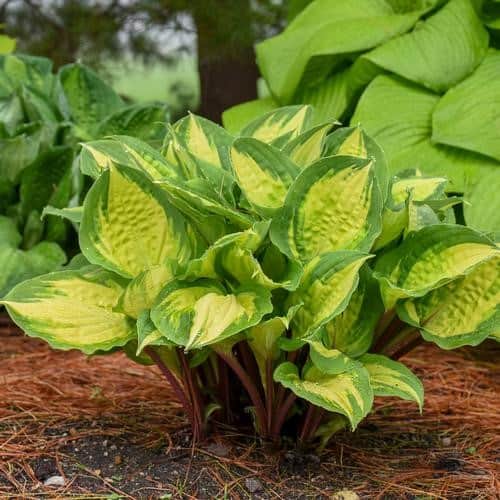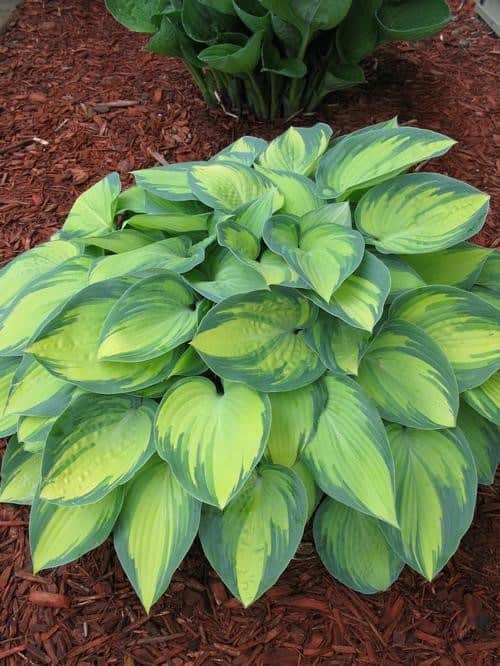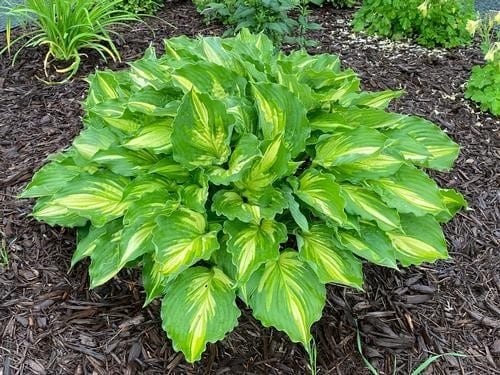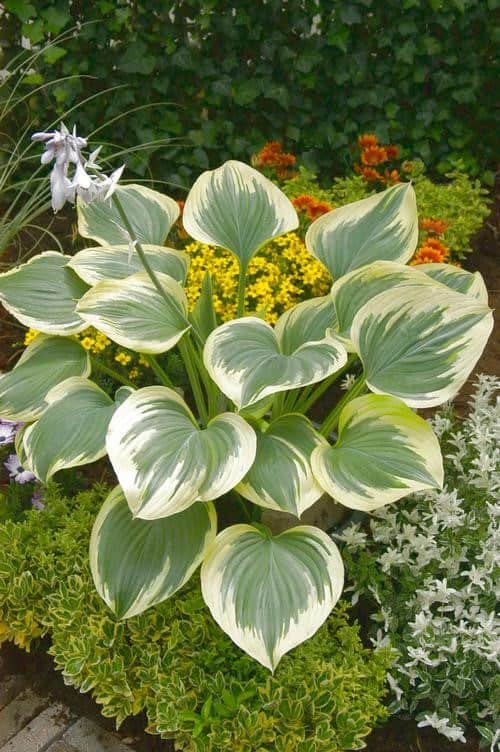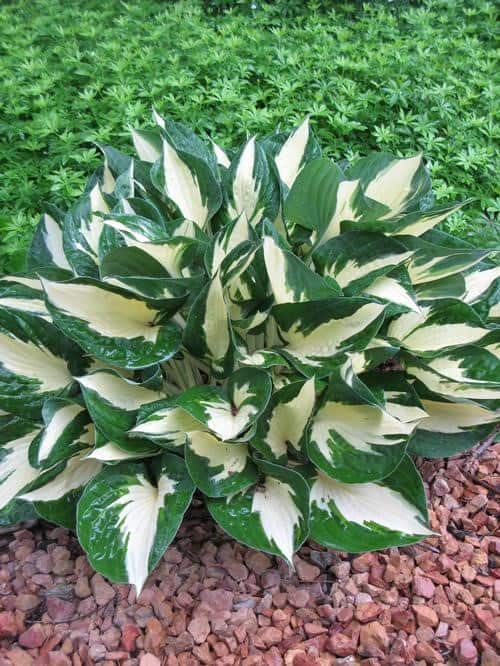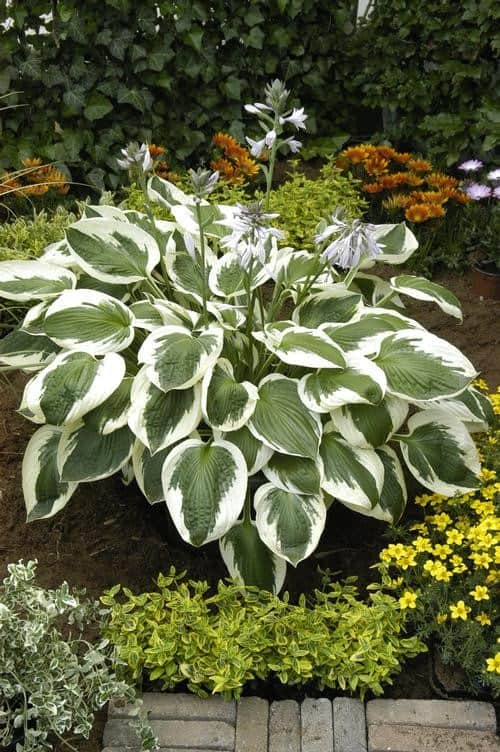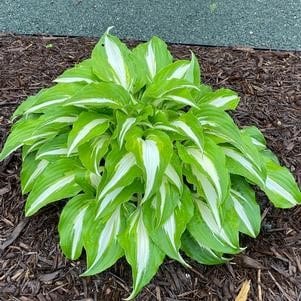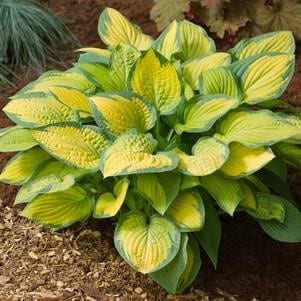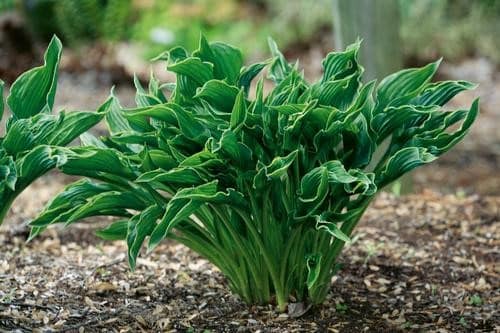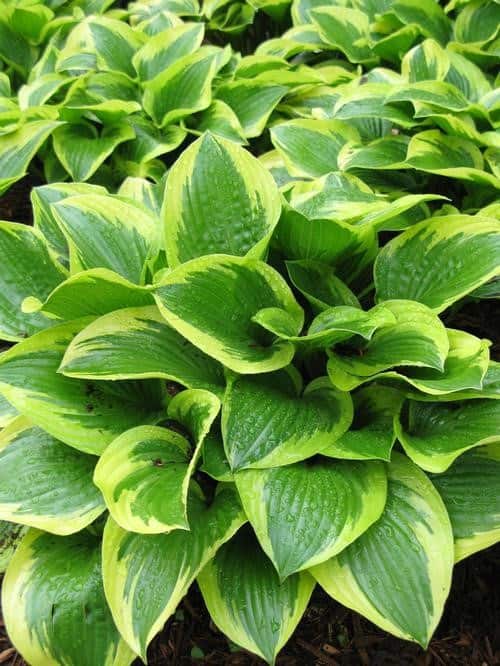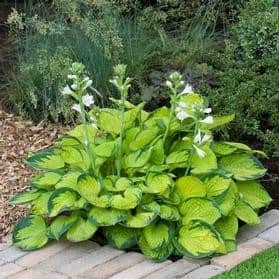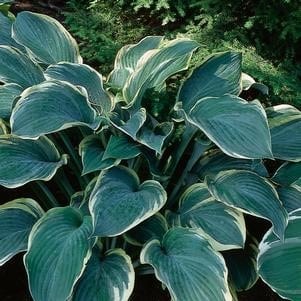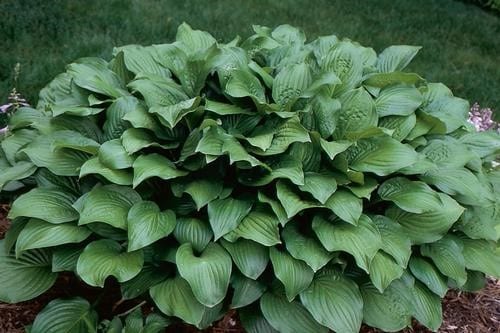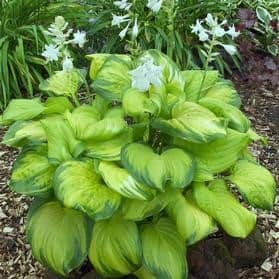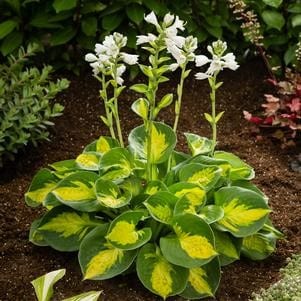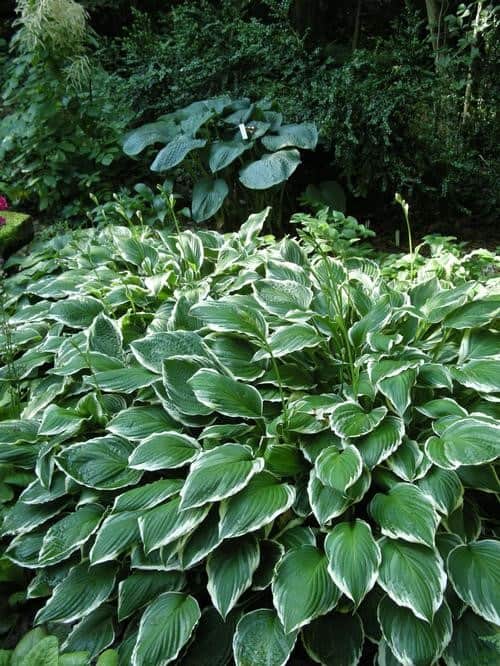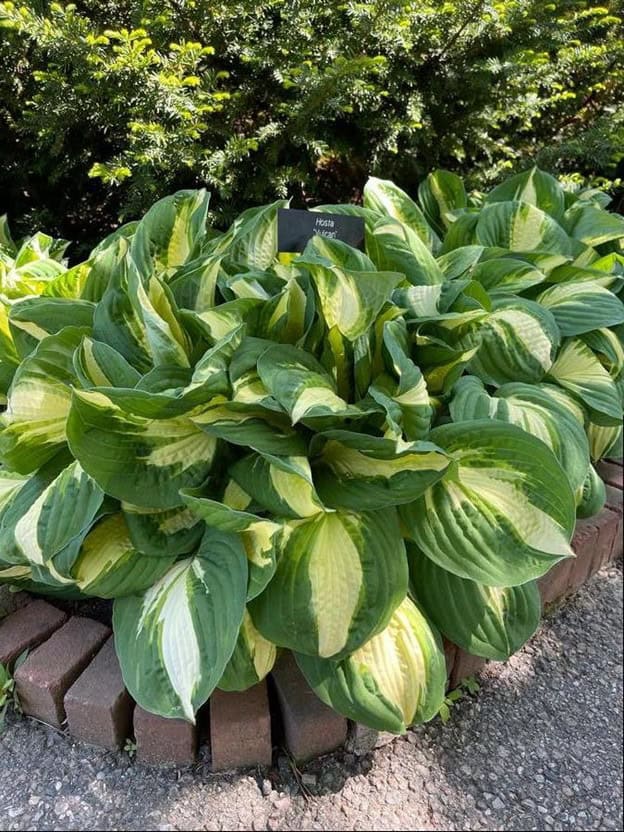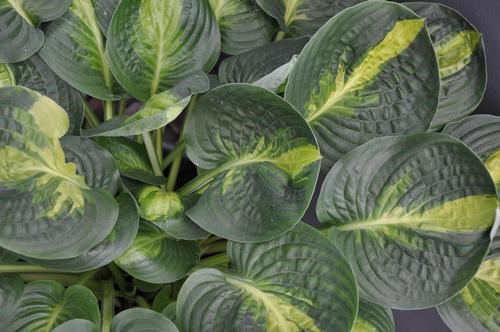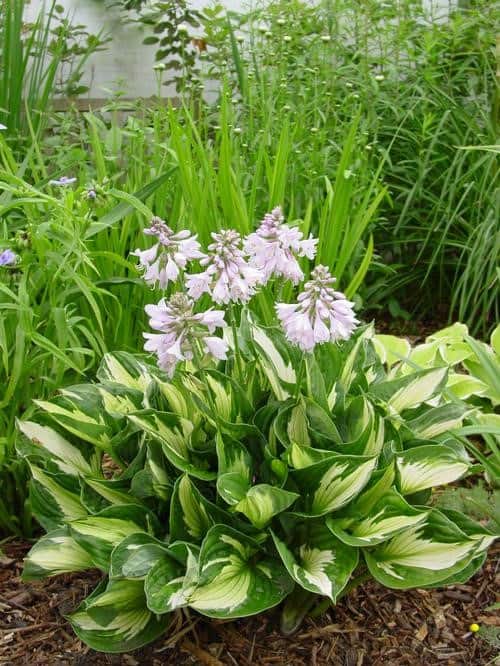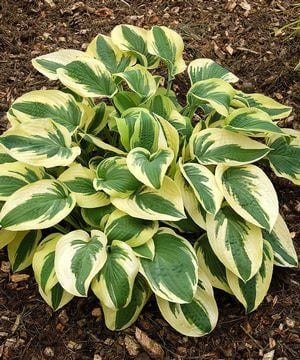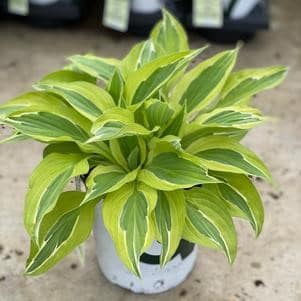Hostas are a popular and versatile plant known for their lush foliage and easy care. They are a favorite among gardeners and landscapers alike for their beautiful colors, interesting textures, and wide range of sizes and shapes. Known for their lush, vibrant foliage and captivating, often fragrant flowers, Hosta brings a touch of sophistication and tranquility to outdoor spaces. Martin Garden Center sells over 1000 Hostas each year, most of which come in a 1-gallon container.
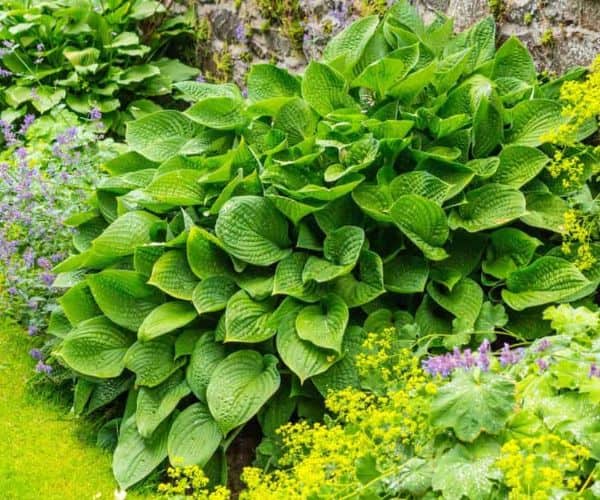
Growing and Caring For Hosta
Hostas are shade-loving plants, and selecting an appropriate planting site is crucial for their success. Optimal conditions include dappled or filtered shade, as direct sunlight can scorch their leaves. Hostas prefer well-drained soil rich in organic matter. Amending the soil with compost before planting enhances fertility and moisture retention. Proper drainage is essential to prevent issues like root rot, so avoiding waterlogged conditions is crucial.
Planting hostas in the fall is ideal but during the winter, the 1-gallon hosta contaner is just a bucket of dirt because hosta is a herbaceous perennial whose foliage dies to the ground after first frost. Consequently, you should plant hostas in fall or early spring (after foliage shows above ground), and this allows them to establish their root systems before facing extreme summer hot weather conditions. Dig a hole slightly wider and no deeper than the root ball when planting. Position the hosta in the center of the hole, ensuring the crown (where the roots meet the foliage) is at or slightly above the soil level. Backfill the hole with soil and water thoroughly. Planting hostas with adequate spacing allows for good air circulation, reducing the risk of diseases.
Hostas benefit from consistent moisture, especially during dry periods. Water deeply to ensure the soil remains consistently moist but not soggy. Applying a layer of organic mulch around the base of the plants helps retain soil moisture, regulates temperature, and suppresses weeds. Mulching is particularly beneficial in winter, providing insulation for the roots.
Hostas are not heavy feeders but benefit from occasional fertilization to promote healthy growth and vibrant foliage. Apply a balanced, slow-release fertilizer in early spring as new growth emerges. Remove dead or yellowing leaves throughout the growing season to maintain the plant’s aesthetic appeal. However, the most significant pruning activity is typically division, which rejuvenates the plant and prevents overcrowding. Divide hostas every few years in the spring or fall when they become too large. Lift the entire plant, divide the crown and roots into sections, and replant the divisions at the desired spacing.
Hostas are generally hardy, but like any plant, they can face challenges with common pests like slugs and snails. Implementing slug-resistant practices, such as copper barriers or organic slug bait, can help manage these pests. While hostas are relatively disease-resistant, proper spacing, good air circulation, and avoiding overhead watering can reduce the risk of issues like foliar diseases.
Size and Shape
Hostas come in many different sizes and shapes, with over 3,000 cultivars available. They range in size from miniature varieties that only grow a few inches tall to large varieties that can grow up to 4 feet in height and spread up to 6 feet wide. Miniature hostas, standing just a few inches in height, are perfect for edging paths or filling small spaces with their diminutive yet intricate leaves. Medium-sized hostas, typically reaching heights between 12 to 18 inches, provide a versatile middle ground, ideal for creating lush ground covers or filling gaps in garden beds. Large hostas can soar to heights exceeding two feet, making a bold statement in shaded borders or woodland gardens.
The shape of hosta leaves is equally diverse, adding an extra layer of visual interest to these shade-loving perennials. Depending on the cultivar, Hosta leaves can be heart-shaped, oval, lanceolate, or even deeply ribbed. Some hostas feature a cascading or cascading mound shape, creating a graceful, flowing effect. Others have a more upright or vase-like habit, contributing to the garden’s structured and architectural look. The variety in size and shape allows gardeners to curate a hosta collection that not only thrives in the shaded nooks of the garden but also provides a dynamic and visually pleasing tapestry of foliage.
Leaves and Flowers
Hostas are renowned for their captivating foliage, a defining feature that sets them apart in shaded landscapes. The leaves of hostas exhibit a remarkable diversity, ranging from broad and heart-shaped to elongated and lanceolate. The texture can also vary, with some hosta varieties showcasing smooth, glossy surfaces while others boast corrugated or heavily ribbed leaves. One of the most appealing aspects of hosta leaves is the extensive range of colors and variegations, including shades of green, blue, gold, and white. These intricately patterned leaves create a lush and visually engaging display, allowing gardeners to curate a tapestry of textures and hues in shaded areas.
While hostas are primarily prized for their foliage, their flowers add an elegant and temporary dimension to their overall charm. Hosta blooms emerge on tall, slender stalks, rising above the foliage in mid to late summer. The flowers are typically bell-shaped and come in soft, pastel colors, including lavender, white, and pale pink. While not as conspicuous as the leaves, the blooms contribute to the seasonal allure of hostas, attracting pollinators to the shaded garden. However, the stunning diversity of hosta leaves remains the focal point, ensuring these perennials remain cherished for their ornamental foliage throughout the growing season.
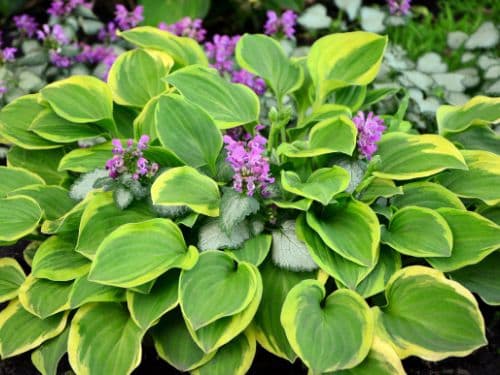
Our Selection Of Hostas
Martin Garden Center attempts to grow 15-20 varieties each year, and also offers tubers for sale in the early Spring. Register for our e-mail to be notified. These varieties are grown at Martin Garden Center, though not every variety will always be available:
Hosta ‘Abiqua Drinking Gourd’
Medium-large puckered, powder-blue leaves with chalky undersides are uniquely upward facing and deeply cupped. White flowers bloom midsummer; very slug resistant. 22″H. Description and picture courtesy of Garden World.
Hosta ‘August Moon’
Medium-large, round corrugated golden leaves under near white flowers. 20”H. Description and picture courtesy of Garden World.
Hosta ‘Ben Vernooij’
A medium, tetraploid sport of First Frost resulting in incredible thick foliage. Intense blue leaves with yellow edges that turn creamy white in summer, holds its color and form until frost; light lavender flowers bloom midsummer. 16″H. Description and picture courtesy of Garden World. $7.99 #1 Division Tuber.
Hosta ‘Big Daddy’
Large, round & very puckered cup-shaped deep blue leaves; Heavy substance and pest resistant. Very floriferous with white flowers. 24″H. Description and picture courtesy of Garden World. $7.99 #1 Division Tuber.
Hosta ‘Blue Angel’
Giant, heart-shaped, blue green heavily textured leaves under dense hyacinth-like white flowers. 36”H. Description and picture courtesy of Garden World.
Hosta ‘Blue Mouse Ears’
Adorable miniature Hosta with perfect form. Small round blue-green leaves are slightly cupped and resemble little mouse ears! Leaves have excellent substance and form a perfectly tight little mound; lavender flowers bloom midsummer. 8″H. Description and picture courtesy of Garden World.
Hosta ‘Brother Stefan’
Large; heavily corrugated and puckered leaves that are blue-green with a bright gold center. Near white flowers are loved by hummingbirds and will appear in early summer. Thick leaves are more slug resistant. 20″H. Description and picture courtesy of Garden World. $8.99 #1 Division Tuber.
Hosta ‘Bulletproof’
Medium; the name Bulletproof comes from its extremely thick and rubbery blue leaves that are slug resistant. The blue color holds all season long. Flowers appear in midsummer. A tetraploid sport of Hosta Halcyon. 13″H. Description and picture courtesy of Garden World. $8.99 #1 Division Tuber.
Hosta ‘Cherry Berry’
Small but very colorful! Narrow lance-shaped white centered leaves with green margins and streaked with white flames; bright red petioles, red scapes, and bright red seed pods add color. Lavender flower bloom mid-late summer. 10″H. Description and picture courtesy of Garden World. $7.99 #1 Division Tuber.
Hosta ‘Curly Fries’
Small, miniature arching mound of shiny yellow-green curly and twisted narrow leaves; 10”H. Description and picture courtesy of Garden World.
Hosta ‘Dancing Queen’
Medium; the foliage of Dancing Queen will emerge and stay yellow throughout the summer unlike other similar varieties that eventually turn green. Yellow color is most intense in part sun; leaf edges are ruffled for added interest. Lavender flowers bloom in late summer. 18″H. Description and picture courtesy of Garden World.
Hosta ‘Earth Angel’
Giant; this spectacular new sport from Blue Angel has huge blue-green pointed leaves with wide creamy white margins. Thick leaves have good substance and deep attractive ribs. Pale lavender flowers bloom midsummer. Very impressive mature clumps can reach 5′ across. 30”H. Description and picture courtesy of Garden World.
Hosta ‘Elegans’
Giant heart-shaped heavily puckered blue-gray leaves are pest resistant. Near white flowers on short scapes. 30”H Description and picture courtesy of Garden World. $7.99 #1 Division Tuber.
Hosta ‘Empress Wu’
Giant corrugated heart shaped green leaves … the largest hosta available spreading 6-7 feet and measuring up to 48″ in height. Description and picture courtesy of Garden World.
Hosta ‘Fire and Ice’
Medium-large heart-shaped white leaves with wide dark green edge and lavender flowers. Reverse of Patriot. 20”H. Description and picture courtesy of Garden World. $7.99 #1 Division Tuber.
Hosta ‘Fire Island’
Medium; spectacular bright gold foliage will contrast dramatically against red petioles and speckles of red reach into the base of the leaves. Lavender flowers bloom midsummer; Vigorous growing variety that prefers shade. 12”H. Description and picture courtesy of Garden World.
Hosta ‘First Frost’
Medium; a sport of Halcyon has intense blue-green leaves with creamy yellow margins in spring; margins turn to white and lavender flowers emerge by midsummer. Great substance and very pest resistant. Named because plants look fantastic until the first frost! Description and picture courtesy of Garden World. $7.99 #1 Division Tuber.
Hosta ‘Forbidden Fruit’
Large. A tetraploid sport of Orange Marmalade. Forbidden Fruit has blue-green edges with a golden-orange center. Thick leaves help deter slugs and hold the foliage color all summer. Perfect for borders and containers, very vigorous. Lavender flowers in midsummer. 20”H. Description and picture courtesy of Garden World. $7.99 #1 Division Tuber.
Hosta ‘Aureomarginata’
Medium; dark green with golden-yellow edge and lilac flowers. 20”H. Description and picture courtesy of Garden World.
Hosta ‘Francee’
Medium-large; dark green leaves with narrow white edges and lavender flowers; sun tolerant. 20”H. Description and picture courtesy of Garden World. $6.99 #1 Division Tuber.
Hosta ‘Frances Williams’
Large; heavily puckered blue-green leaves with wide irregular yellow edge and white flowers. 22”H. Description and picture courtesy of Garden World.
Hosta ‘George Smith’
Medium to large, sport of ‘Elegans’. Gold-centered leaves with wide, blue-green margins are heart shaped and heavily puckerd. Near white flowers in early spring. 22”H. Description and picture courtesy of Garden World.
Hosta ‘Gold Standard’
Medium-large; light green turning gold in summer with dark green edge and lavender flowers. 20”H. Description and picture courtesy of Garden World. $7.99 #1 Division Tuber.
Hosta ‘Golden Tiara’ – Medium; a Hosta with a tidy dense form of heart-shaped green leaves with chartreuse-yellow margins. Showy purple flowers appear in summer; tolerant of dry soils. 16”H. Description and picture courtesy of Garden World. $7.99 #1 Division Tuber.
Hosta ‘Great Expectations (sieboldiana) – Giant; Great Expectations was named for the fact that it is slow growing but eventually turns into a great specimen. Large puckered yellow-edged leaves with wide blue and green margins are worth the wait! White flowers appear in midsummer; slug resistant too. 24”H. Description and picture courtesy of Garden World.
Hosta ‘Guacamole’ – Medium-large; shiny round leaves with gold center and wide green edge under large fragrant lavender flowers. Rapid grower; Sport from Fragrant Bouquet. 22”H. Description and picture courtesy of Garden World.
Hosta ‘Halcyon’ – Medium; spearhead-shaped chalky-blue leaves with heavy ribbing and pale lavender flowers. Thick substance, pest resistant, tolerates partial sun. 20”H. Description and picture courtesy of Garden World.
Hosta ‘Hans’ – Sport of Hosta ‘Andrew’; corrugated, puckerd and folded leaves with broad creamy centers and wide blue-green margins. Apple green brushstrokes and pale lavender flowers appear late summer. 21”H. Description and picture courtesy of Garden World.
Hosta ‘Island Breeze’ – Medium, improved sport of ‘Paradise Island’, wide, dark green margins stand in sharp contrast to the bright yellow centers in early spring, centers become more chartreuse in summer, showy red speckled petioles bleed up into the leaves, dark lavender flowers in summer. Hosta of the Year 2022! 12”H. Description and picture courtesy of Garden World.
Hosta ‘June’ – Small-medium; spearhead-shaped leaves with irregular blue-green edges, chartreuse centers fading to white; lavender flowers. Heavy substance, slug resistant; tolerates partial sun. 15”H. Description and picture courtesy of Garden World.
Hosta ‘Krossa Regal’ – Very large gray-blue hosta forms a vase-shaped mound that becomes wider with maturity, wavy blue-green foliage, lavender flowers mid to late summer, slug resistant. 30”H. Description and picture courtesy of Garden World.
Hosta ‘Lakeside Paisley Print’ – Small; 6″ heart-shaped leaves develop distinct markings that resemble white feathers placed on the center rib of the wavy edged deep green leaf; 24″ scape of lavender flowers bloom mid-late summer. 12”H. Description and picture courtesy of Garden World.
Hosta ‘Liberty’ – Large, sport of Sagae, large blue-green foliage with wide irregular yellow margins, yellow edges mature to creamy white by summer, more upright vase-shaped growth habit, heavy substance offers good slug resistance, lavender flowers. 24”H. Description and picture courtesy of Garden World.
Hosta ‘Loyalist’ – Medium; reverse variegation sport of ‘Patriot’. The center is nearly pure-white and the margins are deep green. There is a lighter green streak where the leaf center and margin overlap. Pretty lavender blooms appear on creamy white stems in midsummer. 12”H. Description and picture courtesy of Garden World.
Hosta ‘Minuteman’ – Medium; improved Patriot with heavier substance and slightly cup-shaped leaves have dark green centers with creamy white edges under pale lavender flowers. 22″H. Description and picture courtesy of Garden World. $7.99 #1 Division Tuber.
Hosta ‘Night Before Christmas’ – Large; pointed dark green leaves with narrow white centers under pale lavender flowers. Slightly wavy with heavy substance; more upright growth. 26”H. Description and picture courtesy of Garden World. $7.99 #1 Division Tuber.
Hosta ‘Paradigm’ – Medium; chartreuse-gold leaves have wavy blue margins. The variegation will darken as season progresses; leaves are thick and corrugated which makes them slug resistant. Lavender flowers appear in summer. 20”H
Hosta ‘Patriot’ – Medium-large; dark green oval leaves with pure white margins under lavender flowers. Nice color all season; sun tolerant. 22”H. Description and picture courtesy of Garden World. $7.99 #1 Division Tuber.
Hosta ‘Paul’s Glory’ – Medium; chartreuse heart-shaped leaves changing to bright gold to white with narrow irregular blue-green margins under pale lavender flowers. Very colorful with good substance. 25”H. Description and picture courtesy of Garden World. $7.99 #1 Division Tuber.
Hosta ‘Praying Hands’ – Medium; very unique hosta forms clumps of upright facing foliage; the upright narrow leaves remain curled and have a thin creamy edge along the wavy margins under pale lavender flowers. Very unique appearance. 20”H. Description and picture courtesy of Garden World. $8.99 #1 Division Tuber.
Hosta ‘Queen Josephine’ – Medium; smooth, glossy and round green leaves are edged with yellow margins that will turn to cream in summer under purple flowers that appear midsummer. 16”H. Description and picture courtesy of Garden World.
Hosta ‘Rainforest Sunrise’ – Small; slightly cupped, corrugated leaves have florescent gold centers and deep green margins. Thick substance and very slug resistant; a strong grower with bright summer color. 10”H. Description and picture courtesy of Garden World. $7.99 #1 Division Tuber.
Hosta ‘Regal Splendor’ – Giant; summer leaves are frosty blue with creamy yellow to white margins, leaves have good substance. Lavender flowers on tall 4-5′ scapes. 36”H. Description and picture courtesy of Garden World. $7.99 #1 Division Tuber.
Hosta ‘Royal Standard’ – Medium; glossy apple-green leaves with attractive ribbing under fragrant white flowers on 36″ scapes. Very drought tolerant. 18”H. Description and picture courtesy of Garden World.
Hosta ‘Snake Eyes’ – Large, a sport of ‘Striptease’ that has a more prominent white line between margin and center. Fast grower with lavender flowers. 24”H. Description and picture courtesy of Garden World.
Hosta ‘Stained Glass’ – Medium; a sport of Guacamole with similar look and growth but with brighter variegation. Large 10″ brilliant gold leaves with wide dark green margins; variegation appears early and last throughout the growing season. Deep veins give it a stained-glass look. Large fragrant pale lavender flowers. 15”H. Description and picture courtesy of Garden World. $7.99 #1 Division Tuber. $7.99 #1 Division Tuber.
Hosta ‘Sunset Grooves’ – Small; a sport of ‘Rainforest Sunrise’. Round puckered, thick yellow leaves with a wide dark green margin under pale lavender flowers bloom mid-late summer. Description and picture courtesy of Garden World. 12″H. $7.99 #1 Division Tuber.
Hosta ‘undulata Albomarginata’ – Medium; landscaping standard. Green leaves with white margins under lavender flowers. 18”H. Description and picture courtesy of Garden World.
Hosta ‘Victory’ – Giant; huge heart-shaped shiny green leaves with yellow margins. Excellent substance, more upright and arching growth habit. Light lavender flowers bloom on exceptionally long arching scapes. 34”H
Hosta ‘Vulcan’ – Medium; a sport of Captain Kirk. The white centers boldly contrast with the dark green margins, chartreuse streaks appear between the white and green of each leaf, a vigorous grower with lavender flowers that appear in summer. 22”H
Hosta ‘Warwick Comet’ – Medium size variety. Corrugated, cupped leaves are dark green with a gold center; center will become creamy-white in late summer. 18”H. Description and picture courtesy of Garden World.
Hosta ‘Whirlwind’ – Medium; upright pointed leaves are twisted and folded. Creamy yellow to white centers with very dark green margins under lavender flowers; very heavy substance, pest resistant. 16″ H. Description and picture courtesy of Garden World. $7.99 #1 Division Tuber.
Hosta ‘Wide Brim’ – Medium; heart-shaped green leaves with wide irregular creamy-yellow margins. Good substance with slight puckering under pale lavender flowers. 20”H. Description and picture courtesy of Garden World.
Hosta ‘Yellow Polka Dot Bikini’ – Small; leaves emerge cupped and dark green with bright yellow margins and white streaks near the leaf center. The margins eventually flatten out and change to apple green. Lavender flowers bloom in summer. 9″H. Description and picture courtesy of Garden World. $7.99 #1 Division Tuber.
Frequently Asked Questions
Can You Plant Hosta Seeds Directly In The Ground?
While hostas are primarily propagated through division, it is possible to grow them from seeds, though it’s not the most common method. If you’re up for the challenge, here’s what you need to know about planting hosta seeds directly in the ground:
- Seed Selection: Hosta seeds are typically obtained from mature plants after they have bloomed. Look for pods or capsules that contain seeds. Harvest them when the pods start to turn brown and crack open. Ensure that the seeds are fully mature and dry before planting.
- Soil Preparation: Hostas prefer well-draining soil with plenty of organic matter. Before planting, loosen the soil to a depth of at least 6 inches (15 cm) and amend it with compost or well-rotted manure to improve fertility and drainage.
- Site Selection: Choose a planting site that receives partial to full shade. Hostas thrive in shady conditions, though some varieties can tolerate more sunlight. Avoid areas with heavy foot traffic or competition from aggressive weeds.
- Planting Time: The best time to plant hosta seeds is early spring or late summer. This allows the seeds to establish before extreme temperatures set in. If planting in spring, wait until the soil has warmed up and is workable.
- Planting Depth: Sow the hosta seeds directly into the prepared soil at a depth of about ¼ inch (6 mm). Space the seeds at least 6 to 12 inches (15 to 30 cm) apart to provide ample room for growth.
- Watering: Keep the soil consistently moist but not waterlogged. Water the newly planted seeds gently to avoid displacing them. A fine mist or a watering can with a rose attachment can help distribute water evenly.
- Mulching: Apply a layer of organic mulch, such as shredded bark or compost, around the planted area to help retain moisture and suppress weeds. Avoid covering the seeds directly with mulch, as this can inhibit germination.
- Patience and Care: Hosta seeds can take several weeks to germinate, so be patient and keep the soil consistently moist during this time. Once the seedlings emerge, regular watering is provided, and pests or diseases are monitored.
- Transplanting: As the seedlings grow, thin them out to allow the strongest plants to thrive. Once they reach a size of 2 to 3 inches (5 to 7.5 cm) tall, you can transplant them to their permanent location, spacing them according to the mature size of the hosta variety.
- Long-Term Maintenance: Hostas grown from seed may take a few years to reach maturity and develop the lush foliage for which they are known. To maintain vigor, provide regular care, including watering during dry periods, fertilizing in spring, and dividing overcrowded clumps every few years.
Do Snakes Like Hosta?
While not drawn to hosta plants specifically, Snakes may occasionally seek refuge in hosta beds or similar garden environments. While hostas themselves aren’t a primary food source for snakes, the dense foliage and moist soil often found in hosta beds can create suitable habitat conditions. Hosta beds can offer hiding spots for snakes seeking refuge from predators or extreme weather conditions. They may use the dense vegetation for cover during periods of rest or when hunting small prey like insects, rodents, or slugs that might be attracted to the garden.

